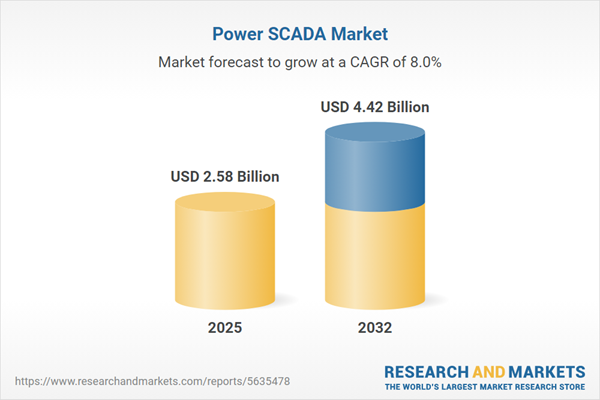Speak directly to the analyst to clarify any post sales queries you may have.
Power SCADA solutions are becoming indispensable for senior decision-makers seeking to modernize industrial and energy operations. As digital integration accelerates across sectors, organizations require advanced tools to ensure operational resilience and efficiency while adapting to evolving industry dynamics.
Market Snapshot of the Power SCADA Market
The global Power SCADA market is experiencing sustained growth, with research indicating market size expansion from USD 2.39 billion in 2024 to USD 2.58 billion by 2025, representing a CAGR of 7.98 percent and an expected valuation of USD 4.42 billion by 2032. This trajectory is fueled by increased demand for centralized control, expanded integration of distributed energy resources, and greater reliance on Supervisory Control and Data Acquisition technology to bolster grid stability. As organizations contend with heightened cybersecurity requirements, robust real-time monitoring is equipping leaders to manage sector complexities and meet new compliance standards with confidence.
Scope & Segmentation: Power SCADA Market
- Core System Components: Deployments often feature actuators, programmable logic controllers (PLCs), remote terminal units, sensors, human-machine interfaces, and specialized SCADA software. Supporting services, such as consulting, system integration, and asset management, ensure seamless rollouts and support system scalability as organizations grow.
- Application Use Cases: Power SCADA platforms enable feeder automation, power generation oversight, substation management, and sophisticated volt-var optimization. This broad functionality delivers improved transparency, operational reliability, and alignment with critical performance mandates across diverse sectors.
- End User Sectors: Adoption spans industries including automotive, food and beverage, pharmaceuticals, oil and gas, utilities, port operations, airports, and railways. Each sector benefits from tailored system configurations that address unique operational needs and regulatory conditions.
- Deployment Models: Enterprises have the flexibility to select on-premises, private cloud, public cloud, or hybrid deployments, allowing them to match their workflow demands and security requirements with suitable technology environments.
- Communication Technologies: Reliable communication is achieved through ethernet, fiber optic, serial, cellular, radio, and satellite channels. This diversity enables effective data exchange across varied infrastructure and geographic scenarios.
- Regional Landscape: The market encompasses North and South America, Europe, the Middle East and Africa, and Asia-Pacific. Rapid adoption is underway in China, India, Japan, and Australia, propelled by significant modernization initiatives and infrastructure investment, intensifying demand throughout these regions.
- Major Vendors: Notable suppliers such as Schneider Electric SE, Siemens AG, ABB Ltd, General Electric Company, Emerson Electric Co., Honeywell International Inc., Mitsubishi Electric Corporation, Rockwell Automation, Yokogawa Electric Corporation, and Hitachi Energy Ltd. deliver scalable Power SCADA solutions that support various deployment scenarios and expansion strategies.
Key Takeaways: Strategic Insights for Power SCADA Stakeholders
- Real-time monitoring combined with advanced analytics empowers executives to make informed, timely decisions that strengthen asset management and operational control.
- Modular SCADA systems simplify integration with IoT technologies and cloud platforms, supporting organizational growth and long-term scalability.
- Continuous cybersecurity improvements remain vital, shielding technology environments as automation and interconnectivity increase within new and legacy systems.
- Regional adoption patterns are shaped by local policy initiatives and infrastructure investments, resulting in distinct modernization strategies across global markets.
- Collaboration with established vendors accelerates solution customization and streamlines energy management projects from concept planning through execution.
- Investing in targeted workforce training ensures compliance and safety, maximizing the benefits of advanced SCADA deployments as systems become more complex.
Tariff Impact on the Power SCADA Market
Evolving United States tariff policies are leading enterprises involved with Power SCADA components to revisit their supply chain strategies. Companies are ramping up domestic manufacturing, expanding their supplier networks, and fine-tuning inventory controls to build stronger, more resilient supply chains that withstand unexpected disruptions.
Methodology & Data Sources
This analysis combines direct interviews with senior energy engineers, extensive technical document review, and comprehensive examination of regulatory developments. Findings are validated through sector-specific workshops, providing assurance that insights remain both reliable and aligned with current Power SCADA market conditions.
Why This Report Matters
- Enables senior leaders and technology planners to develop effective digital transformation strategies that address evolving regulatory and market requirements.
- Delivers actionable insights to guide decisions on operations, procurement, and advanced solution deployment across energy and industrial settings.
- Supports stronger infrastructure management and reduces operational risk by offering timely perspectives for effective decision-making during periods of sector change.
Conclusion
Power SCADA technologies are a cornerstone for agile and sustainable energy and industrial operations. Ongoing advances in digital integration, risk management, and regulatory responsiveness will shape the sector’s development and strategic direction moving forward.
Additional Product Information:
- Purchase of this report includes 1 year online access with quarterly updates.
- This report can be updated on request. Please contact our Customer Experience team using the Ask a Question widget on our website.
Table of Contents
3. Executive Summary
4. Market Overview
7. Cumulative Impact of Artificial Intelligence 2025
Companies Mentioned
The companies profiled in this Power SCADA market report include:- Schneider Electric SE
- Siemens AG
- ABB Ltd
- General Electric Company
- Emerson Electric Co.
- Honeywell International Inc.
- Mitsubishi Electric Corporation
- Rockwell Automation, Inc.
- Yokogawa Electric Corporation
- Hitachi Energy Ltd
Table Information
| Report Attribute | Details |
|---|---|
| No. of Pages | 192 |
| Published | October 2025 |
| Forecast Period | 2025 - 2032 |
| Estimated Market Value ( USD | $ 2.58 Billion |
| Forecasted Market Value ( USD | $ 4.42 Billion |
| Compound Annual Growth Rate | 7.9% |
| Regions Covered | Global |
| No. of Companies Mentioned | 11 |









